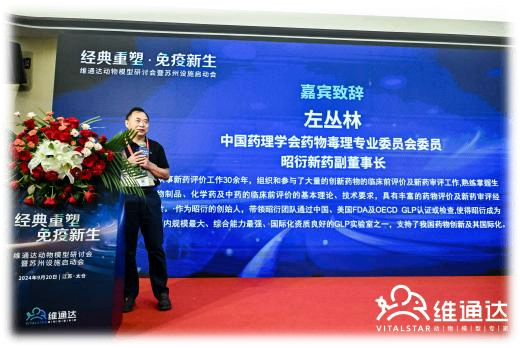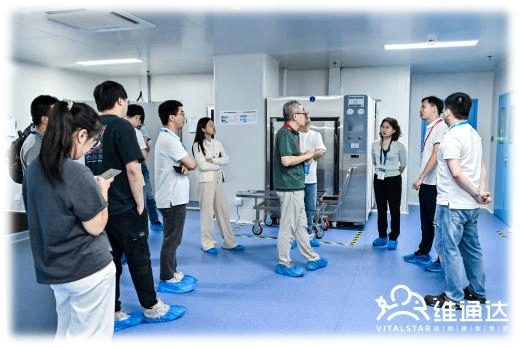On September 20, 2024, Vitalstar successfully held the "Classic Reinvention · Immunological Rebirth" Animal Model Seminar in Taicang and officially unveiled the animal facility located in Taicang, Jiangsu. Industry leaders, experts, and partners from all over the country gathered together to witness this important moment.
At the meeting, Vitalstar was honored to invite Mr. Baojin Wu, Vice Chairman of the China Laboratory Animal Association and Chairman of the Shanghai Laboratory Animal Association; Mr. Jianhong Wang, Deputy Director of the Management Committee of Taicang Bio-Pharmaceutical Industry Park and Member of the Shaxi Town Party Committee; Dr. Chun Liu, Deputy Director of the Experimental Animal Center of Nantong University and Director of the Jiangsu Laboratory Animal Association; Mr. Zhenhui Zheng, Vice President of the Beijing Laboratory Animal Association; and Mr. Conglin Zuo, Member of the Pharmacology Society of China's Toxicology Professional Committee and Vice Chairman of Zhaoyan, to congratulate and deliver speeches.




Ms. Wei Lin, Chairman of Vitalstar, extended her sincerest greetings and warm welcome to every guest at the opening ceremony. She stated that the commissioning of Suzhou Vitalstar's new production and experimental facilities marks not only a new starting point for the company but also an important milestone that spurs Vitalstar's continuous growth. The company has always adhered to the core values of "meticulously researching animal models to promote biomedicine," focusing on customers and driven by technological innovation, constantly exploring and breaking through to forge ahead steadily in the market tide. At the same time, the launch of the new R&D and production base is a key step for Vitalstar to continue expanding market scale and enhancing industry competitiveness in the history of the company's development.
Dr. Ming Yin, Deputy General Manager of Vitalstar, expressed that Vitalstar's growth is inseparable from the efforts of every employee and the trust and support of partners. Today, we are here to celebrate the launch of the new Suzhou facility and share the company's latest progress in disease model research with everyone.
Mr. Luping Che, Deputy General Manager of Vitalstar, introduced in detail the company's current animal facilities in Beijing and Gu'an, with a particular focus on the animal housing facilities, quality control, and testing standards in Taicang. He also led the attendees on a tour to explain the environment and technical equipment of the animal housing facilities.




The Academic Conference of September 20th Afternoon
We were honored to invite Lin Guo, Executive Director of CrownBio, General Manager of Zhaoyan Yichuang (Suzhou) New Drug Research Co., Ltd., Zhenchuan Miao, R&D Director of Vitalstar, Shujun Liu, Director of Model Services Department, and Weifeng Yang, Director of Product Services Department, as five speakers to give presentations on topics such as the development and application of tumor and liver disease animal models, tumor detection technology, new challenges in liver disease immunotherapy and drug development. We built a high-standard and high-quality academic exchange platform to showcase the new achievements and progress of Vitalstar's animal model products, and to promote the integration of model development with the pharmaceutical industry. Below, let's review the wonderful presentations of the experts.
Firstly, Zhenchuan Miao, R&D Director of Vitalstar, gave a presentation titled "New Large and Small Animal Models to Aid in Oncology Research and Drug Development". Dr. Miao discussed Weida's existing self-developed tumor models in four dimensions: mouse tumor models (primary tumors and CDA, GDA models), immunodeficient mice, humanized immune system mice, and immunodeficient rats, and how they are compatible with popular drugs and treatment methods to accurately support life science research. During the presentation, Dr. Miao announced two new products from Vitalstar - 1. The non-irradiation HSC transplantation model NPG-RF, which simplifies the operation process while maintaining excellent reconstruction levels; 2. The new generation of radiation therapy and nuclear medicine exclusive model NRG.
The second speaker was Lin Guo, Executive Director of CrownBio, who gave a presentation titled "Application of MRI in Mouse Orthotopic Models". Mr. Guo discussed the practical use of MRI as a preclinical orthotopic tumor detection technology from the perspectives of Hep3B-luc and U87 MG-luc.
The third presenter was Shujun Liu, Director of the Model Services Department of Vitalstar, who gave a speech titled "Gene-Edited Rats and Mice Models to Support Biomedical Research". Dr. Liu explained the series of models and application technologies built on the GEMS characteristic platform, as well as the breeding and strain preservation of rats and mice. During the presentation, Dr. Liu announced our new spontaneous pancreatic cancer model - KPC mice, which begin to show precursor lesions or pancreatic intraepithelial neoplasia in the pancreas at 8-10 weeks of age.
The fourth speaker was Lin Cao, General Manager of Zhaoyan Yichuang (Suzhou) New Drug Research Co., Ltd., who gave a speech titled "From Non-clinical Research to the MASH Billion-Dollar Blue Ocean Market". Mr. Cao explained from four angles: the development history and diagnostic methods of MASH, MASH treatment targets and drug development, compatible animal models, and the applicability of various MASH models to different target drugs. Mr. Cao also mentioned that when the mechanism of drug action is unclear, it is recommended to choose at least two different models for preclinical validation of drug efficacy.
The last speaker was Weifeng Yang, Director of the Product Services Department of Vitalstar, who gave a presentation titled "Advantages and Disadvantages of Preclinical Liver Disease Models in Rats and Mice and Their Application in Drug Development". Dr. Yang explained the trends and characteristics of viral liver diseases and metabolic disorders (steatosis), AFLD & DIO & MASH & HBV models, GEM-HCC, MASH-HCC & HBV-MASH-HCC models, and Weida's characteristic humanized liver mice Hu-URG®. Dr. Yang mentioned that Hu-URG® can be used for drug metabolism research, drug toxicity evaluation, human liver function research, gene therapy evaluation with the liver as the target organ, and immune therapy evaluation, as well as models for fatty liver, MASH (NASH).





In conclusion, Vitalstar extends its sincere gratitude to every leader, expert, and partner who attended the "Classic Remodeling · Immune Rebirth" seminar and the inauguration of the Taicang facility. Weida remains true to its original aspiration, committed to providing every customer with high-quality animal models and services.

 animalmodel@vital-bj.com
animalmodel@vital-bj.com +8610-84928167
+8610-84928167